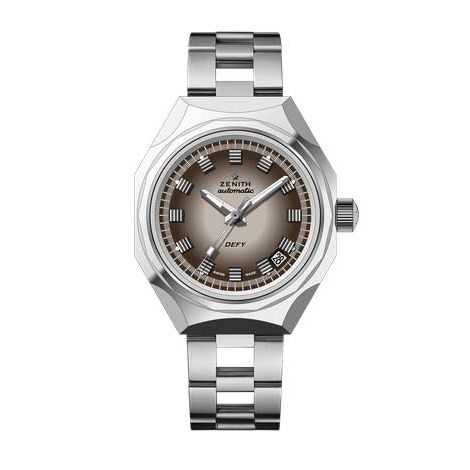

Like the original, the date window is tucked in between the 4 and 5 o’clock markers. Placed discreetly underneath the markers are dots of lume that match the Super-LumiNova used to treat the faceted and rhodium-plated hour, minute and paddle-shaped seconds hands. The iconic rectangular hour markers are faceted, rhodium-plated and polished to highlight the ridges. The taupe fumé dial is identical to the original with a lighter tone in the centre that intensifies as it reaches the white minute and seconds track on the perimeter. The large screw-down crown ensures the 300m water-resistance of the case, although the original screw-down caseback with its four-pointed star has been replaced with a sapphire crystal glass. Using contrasting brushed finishings on the surface of the case and polished bevels, the dynamic architecture of the watch comes to life.


The formidable geometry of the 37mm case with a case height of 13.6mm is faithfully recreated with its thick octagonal and scalloped base and 14-sided raised and polished bezel. The Defy collection also houses less extreme models that display their defiantly contemporary spirit thanks to avant-garde materials and radical skeletonisation.Īs we mentioned, the revival version of the Defy A3642 was created using original production plans to produce an almost perfect reproduction. Following its acquisition by the LVMH group in 2000, the Defy line was revived in 2006 and is now the springboard for Zenith’s technological innovations incarnated in models like the Defy Lab of 2017 with its revolutionary oscillator, the Defy Extreme with two escapements, or the Defy Zero-G and Defy 21 Double Tourbillon Sapphire. However, like many other watchmakers, the rampage of cheap quartz watches flooding the market during the 1970s and 1980s had its effects, and Zenith turned to quartz. New – The Original model (here a version with different markers) next to the new Zenith Defy Revival A3642 Naturally, the markers, hour and minute hands and central seconds hand with its paddle tip were treated with tritium to glow in the dark. The steel ladder bracelet designed and manufactured by Gay Frères could be adjusted and came with a safety clasp. Coupled with the gradient or fumé dial – one of the first of its kind in 1969 – the hour markers with horizontal ridges added a dynamic sense of motion to the dial.

The octagonal case design of the original Defy, with its scalloped edges, contrasting brushed and polished finishings and the dizzying 14-sided bezel, is radical and edgy.


 0 kommentar(er)
0 kommentar(er)
